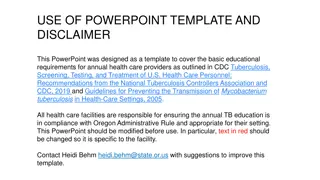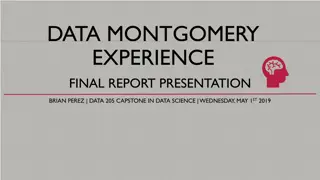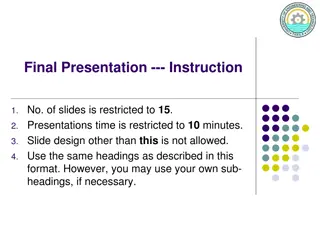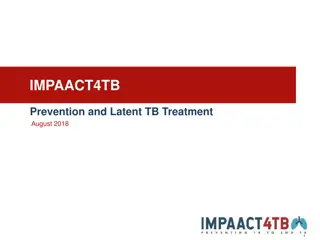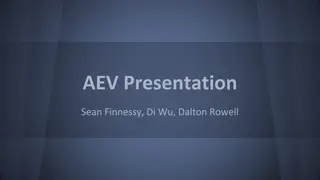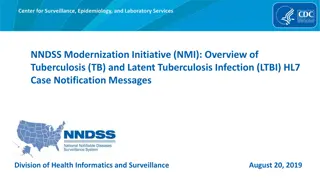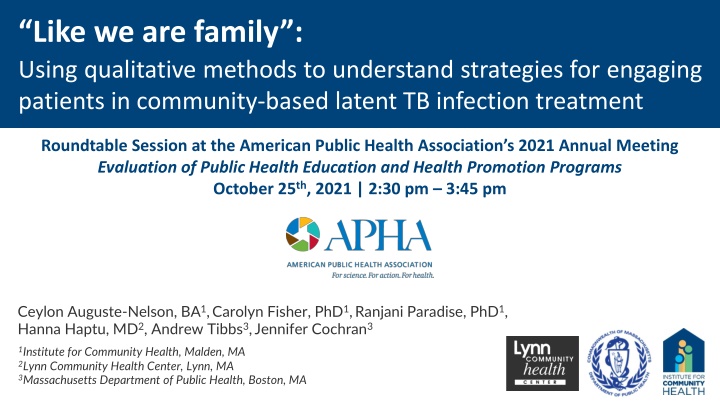
Strategies for Engaging Patients in Community-Based Latent TB Infection Treatment
Explore qualitative methods used to engage patients in community-based treatment for latent tuberculosis infection, with a focus on strategies and outcomes from a demonstration project in Lynn, Massachusetts. The study evaluates public health programs aiming to scale up LTBI testing and treatment, offering insights into successful practices and lessons learned.
Download Presentation

Please find below an Image/Link to download the presentation.
The content on the website is provided AS IS for your information and personal use only. It may not be sold, licensed, or shared on other websites without obtaining consent from the author. If you encounter any issues during the download, it is possible that the publisher has removed the file from their server.
You are allowed to download the files provided on this website for personal or commercial use, subject to the condition that they are used lawfully. All files are the property of their respective owners.
The content on the website is provided AS IS for your information and personal use only. It may not be sold, licensed, or shared on other websites without obtaining consent from the author.
E N D
Presentation Transcript
Like we are family: Using qualitative methods to understand strategies for engaging patients in community-based latent TB infection treatment Roundtable Session at the American Public Health Association s 2021 Annual Meeting Evaluation of Public Health Education and Health Promotion Programs October 25th, 2021 | 2:30 pm 3:45 pm Ceylon Auguste-Nelson, BA1,Carolyn Fisher, PhD1,Ranjani Paradise, PhD1, Hanna Haptu, MD2, Andrew Tibbs3,Jennifer Cochran3 1Institute for Community Health, Malden, MA 2Lynn Community Health Center, Lynn, MA 3Massachusetts Department of Public Health, Boston, MA
Background LATENT TUBERCOLOSIS INFECTION (LTBI) Dormant form of tuberculosis that can develop into active disease Most TB cases in U.S. result from untreated LTBI LTBI is treated through consistent medication regimens over a set number of months Non-US born people have a particularly high risk of LTBI PROJECT CDC funded Massachusetts Department of Public Health (MDPH) to conduct 3-year demonstration project (Oct 2016 Jan 2020) GOAL: Scale up LTBI testing & treatment in a high-risk population
Background SETTING City: Lynn, Massachusetts 1/3 of residents non-US born In 2015, estimated 6,000 non-US born residents with LTBI Clinical Site: Lynn Community Health Center (LCHC) Largest provider of primary care and behavioral health services in Lynn Diverse patient population (data as of 2015) 80% racial/ethnic minorities 55% best served in language other than English 60% living below federal poverty limit 15% had no insurance coverage Began testing and treating patients with LTBI in 2013
Background DEMONSTRATION PROJECT COMPONENTS 1. Collaborative MDPH-LCHC clinical team 2. Community engagement and education 3. Workflow development and process improvement 4. Training and professional development 5. Expanded access to care and social needs support 6. Electronic health record and data reporting improvements 7. Program evaluation
Mixed-methods evaluation Components: Development of LTBI cascade of care framework Quantitative electronic health record analysis Process evaluation and outcomes tracking Qualitative data collection Time-tracking study Goals: Monitor and record data on scale up implementation and outcomes Inform quality improvement Identify successful practices and lessons learned
Qualitative evaluation Data collection activities included: Semi-structured interviews with 13 patients Semi-structured interviews with 2 physicians Structured interviews with 2 clinicians and 3 community health workers Evaluators used a framework analysis to extract key themes about factors supporting patient engagement in, and completion of, their LTBI treatment
Findings Key factors in patient engagement and retention: 1. High touch communication conducted by CHWs and other members of the team 2. Warm and trusting relationships built by LTBI clinical team with patients 3. Flexibility with scheduling and appointments that prioritized patients access to treatment
Illustrative quotes from patients The person who give it to me all the time, the medicine She make me comfortable all the time, so friendly, I love her. So, she make it really easy. Sometimes it is too much medicine for me, but thanks to her she make me finish it I really liked to come over there, even if it wasn t easy every Thursday. [When I finished treatment] I felt like crying because I know I was going to miss them I love you guys [referencing LTBI team], I love the way you interact with me. I love how we talk, we chat like we are family. They were good they are so loving there.
Conclusion For public health program evaluations, qualitative data is a valuable complement to quantitative epidemiological analysis. Qualitative data helps deepen our understanding of program s efforts and outcomes and identify lessons for improvement and replication.





